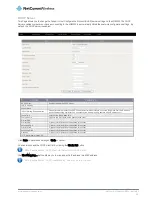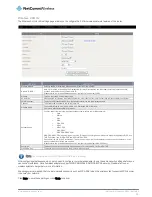
www.netcommwireless.com
NetComm Wireless 4GM3W User Guide
31
Forwarding Rules
The Forwarding Rules page allows you to configure the port forwarding management on the router. Click on any of the menu
items on the left to access the respective settings page.
Forwarding rules are a necessary feature as by default NAT (Network Address Translation) will automatically block incoming traffic
from the Internet to the LAN unless a specific port mapping exists in the NAT translation table. Because of this, NAT provides a
level of protection for computers that are connected to your LAN.
However this also creates a connectivity problem when you want to make LAN resources available to Internet clients. For
example, to play network games or host network applications.
There are three ways to work around NAT and to enable certain LAN resources available from the Internet:
Port Forwarding (available in the Virtual Server page)
Port Triggering (available in the Special AP page)
DMZ Host (available in the Miscellaneous page)
Virtual Server
A virtual server is defined as a Service Port, and all requests to this port will be redirected to the computer specified by the Server
IP.
Virtual Servers can also work with Scheduling Rules, and give you more flexibility on Access control.
Please note: For further instructions on scheduling rules, please refer to the “Scheduling” section later in this guide
For example, if you have an FTP server (the default port is 21) at 192.168.20.10, a Web server (the default port is 80) at
192.168.20.40, and a VPN server (the default port is 1723) at 192.168.20.60, then you would need to specify the following virtual
server mappings:
















































